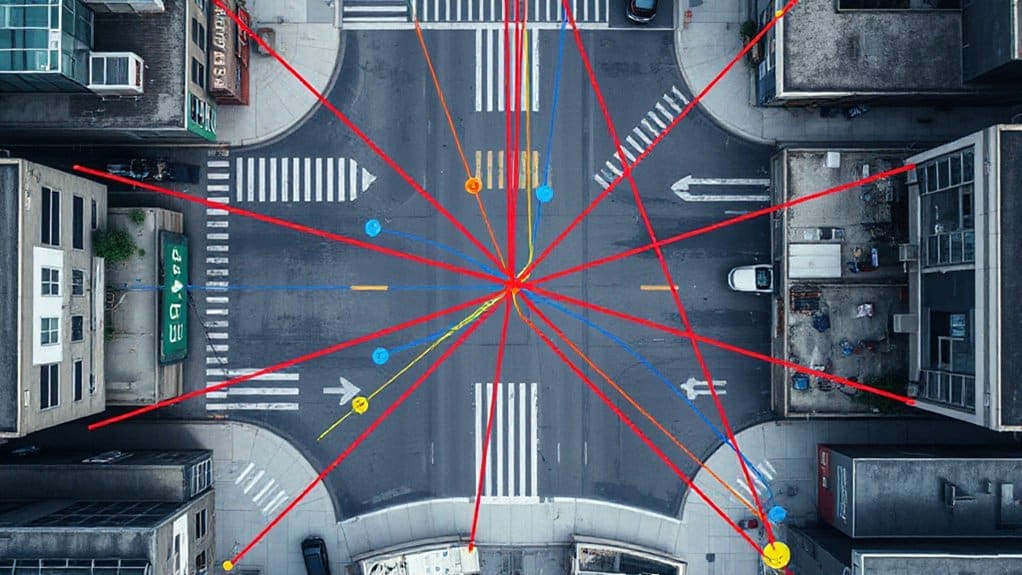Location data serves as critical digital evidence in modern investigations, encompassing cellular tower records, GPS coordinates, vehicle telematics, and smart device histories that triangulate movements with sub-meter accuracy. Specialized software extracts and analyzes this geographic information through standardized protocols ensuring forensic integrity and legal admissibility under Fourth Amendment frameworks. Advanced algorithmic analysis synthesizes diverse data sources into extensive movement narratives, utilizing heat maps and temporal sequencing to reconstruct timelines and verify trajectories for courtroom presentations with enhanced credibility and reliability through professional visualization tools.
Key Takeaways
- GPS-enabled apps and cellular tower records provide precise coordinate data for reconstructing detailed movement patterns and timelines.
- Fourth Amendment protections require warrants for historical location data, with Carpenter v. United States establishing key legal precedents.
- Standardized forensic protocols ensure chain of custody documentation and hash verification maintain evidence integrity for court admissibility.
- Advanced analytics platforms synthesize diverse location sources into visual heat maps and movement narratives for clear courtroom presentations.
- Professional-grade verification methods integrate asset data with location evidence to strengthen case reliability and support legal theories.
Types of Location Data Sources in Modern Investigations

While traditional investigative methods relied heavily on witness testimony and physical evidence, modern investigations increasingly leverage sophisticated location data sources that provide unprecedented precision in tracking movements and establishing geographic connections. Contemporary investigators access multiple data streams including cellular tower records, which triangulate device positions through signal strength analysis, and GPS-enabled applications that capture coordinates with sub-meter GPS accuracy. Vehicle telematics systems record detailed route information, while smart device ecosystems maintain thorough location histories. Credit card transactions, surveillance camera networks, and social media check-ins create additional geographic markers. These diverse sources enable historical tracking of movement patterns across extended timeframes, transforming investigative capabilities through quantifiable, time-stamped evidence that establishes presence, absence, and behavioral patterns with mathematical precision. Therefore, mastering these tools is vital for identifying, preserving, and analyzing digital evidence, enabling investigators to draw more accurate conclusions in their cases.
Legal Framework and Fourth Amendment Considerations
The Fourth Amendment‘s protection against unreasonable searches and seizures creates complex legal boundaries for location data acquisition in criminal investigations. Courts must balance privacy expectations against law enforcement needs when evaluating digital surveillance techniques. Established legal precedents demonstrate evolving judicial interpretations of constitutional protections in the digital age. The Supreme Court’s Carpenter v. United States decision established that accessing historical cell site location information requires a warrant, crucially impacting investigative procedures. However, real-time tracking, third-party doctrine applications, and exigent circumstances create nuanced exceptions requiring careful analysis. Legal professionals must navigate these frameworks while understanding that technological advancement often outpaces judicial guidance, creating uncertainty in novel surveillance scenarios. As the importance of swift action in missing persons cases is emphasized, the intersection of technology and legal considerations becomes increasingly significant.
Digital Evidence Collection Methods and Best Practices
Multiple standardized protocols govern the acquisition, preservation, and analysis of location-based digital evidence to assure forensic integrity and legal admissibility. Investigators employ specialized software tools to extract GPS coordinates, cell tower triangulation data, and Wi-Fi access point logs from mobile devices while maintaining chain of custody documentation. Hash verification algorithms certify data integrity throughout the collection process, creating cryptographic fingerprints that detect any unauthorized modifications. Digital footprints require bit-by-bit imaging of storage media using write-blocking hardware to prevent contamination. Metadata extraction reveals timestamps, accuracy measurements, and device identifiers essential for establishing movement patterns. Professional certification programs train examiners in industry-standard methodologies, guaranteeing consistent application of technical procedures across jurisdictions and maintaining the evidentiary value necessary for successful prosecution outcomes. Moreover, thorough evidence collection is critical in leveraging these digital insights to support legal arguments effectively.
Analyzing Movement Patterns and Timeline Reconstruction

Investigators synthesize location data points into coherent movement narratives through algorithmic analysis of spatial and temporal relationships. Movement analytics platforms process GPS coordinates, cellular tower pings, and Wi-Fi access points to establish precise chronological sequences. Geospatial tracking algorithms identify patterns including velocity calculations, dwell times, and route deviations that reveal behavioral anomalies.
Advanced analytical frameworks correlate multiple data sources to eliminate gaps and verify trajectory accuracy. Machine learning models detect recurring movement patterns, identifying habitual routes versus unusual deviations. Timeline reconstruction requires filtering noise from legitimate location signals while maintaining data integrity.
Professional investigators utilize specialized software that visualizes movement flows through heat maps and trajectory overlays. These technical methodologies enable forensic teams to establish presence at specific locations within defined time windows, supporting evidence-based conclusions. Additionally, understanding legal and ethical guidelines in evidence collection is crucial for ensuring that findings can be utilized effectively in legal scenarios.
Court Admissibility Standards for Geographic Evidence
Although location data provides compelling investigative insights, legal standards for geographic evidence admissibility demand rigorous authentication protocols and chain-of-custody documentation. Courts evaluate geographic reliability through established admissibility criteria including metadata verification, timestamp accuracy, and device calibration records. Expert testimony must demonstrate GPS precision tolerances, cellular triangulation methodologies, and Wi-Fi positioning algorithms underlying location determinations. Practitioners must establish unbroken evidence chains from data extraction through forensic analysis, documenting every access point and transfer. Technical specifications require validation of coordinate systems, datum references, and measurement uncertainties. Legal professionals increasingly recognize that properly authenticated geographic evidence strengthens case foundations, while inadequate documentation risks exclusion. Elder abuse investigations are particularly reliant on accurate geographic data to substantiate claims of mistreatment. Professional standards committees continue developing protocols ensuring geographic evidence meets evolving judicial requirements for scientific reliability and procedural integrity in contemporary litigation environments.
Privacy Rights and Consent Requirements
While geographic evidence strengthens legal proceedings, collection of location data triggers complex privacy frameworks governing individual consent and constitutional protections. Location consent operates through multiple regulatory layers, including Fourth Amendment safeguards, state privacy statutes, and federal telecommunications regulations. Data collectors must navigate varying consent thresholds: explicit opt-in requirements for precise GPS coordinates, implied consent for cell tower triangulation, and retroactive warrant provisions for historical tracking records. Privacy implications extend beyond individual users to encompass third-party doctrine applications, where service providers maintain location databases without direct user knowledge. Legal practitioners must balance evidentiary value against constitutional privacy expectations, particularly when location data reveals intimate personal patterns. Private investigators employ specialized knowledge to navigate these complexities, ensuring compliance with emerging privacy legislation continues reshaping consent requirements, demanding proactive compliance strategies for location-based evidence collection.
Technology Tools for Location Data Analysis and Visualization

Geographic Information Systems (GIS) platforms serve as the foundation for location data analysis, enabling legal professionals to transform raw coordinate datasets into compelling visual narratives for courtroom presentation. Modern practitioners leverage specialized software like ArcGIS, QGIS, and Tableau to conduct sophisticated geospatial analysis, extracting patterns from complex movement data. These tools generate heat maps that reveal concentration zones and behavioral patterns, making abstract location information tangible for judges and juries. Advanced analytics capabilities include temporal sequencing, proximity calculations, and route reconstruction. Legal teams utilize these platforms to overlay multiple data sources, creating detailed spatial stories that support case theories. Professional-grade visualization tools guarantee accurate representation while maintaining data integrity throughout the analytical process, establishing credibility within legal proceedings. Additionally, incorporating findings from asset verification methods enhances the overall strength of location-based evidence in legal cases.
Frequently Asked Questions
How Long Do Mobile Carriers Typically Retain Location Data Records?
Mobile carriers typically maintain location data records for varying periods, with most retaining them between 12-24 months for operational purposes. Data retention policies differ considerably across providers and jurisdictions, influenced by regulatory requirements and business needs. Legal implications surrounding these practices continue evolving, as courts increasingly recognize location data’s evidentiary value. Industry professionals must understand that retention periods directly impact litigation discovery processes and forensic investigations requiring historical movement patterns.
What Costs Are Involved in Obtaining Location Data for Investigations?
Data acquisition costs for mobile location records vary considerably across carriers and jurisdictions. Investigators typically encounter fees ranging from $50-500 per request, depending on data complexity and timeframe. Law enforcement agencies often receive reduced rates compared to civil litigation requests. Investigative budget considerations must account for potential multiple carrier requests, expedited processing fees, and technical analysis costs. Professional investigators recognize these expenses as standard operational requirements within extensive case development strategies.
Can Location Data Be Recovered From Damaged or Destroyed Devices?
Data recovery from compromised devices depends on damage severity and device forensics capabilities. Physical destruction may render extraction impossible, while water damage or corruption often allows partial recovery through specialized techniques. Evidence preservation protocols require immediate professional intervention to maximize retrieval success. Technology limitations include encrypted storage, corrupted memory sectors, and complete hardware failure. Recovery rates vary greatly based on device type, damage extent, and investigator expertise levels.
How Accurate Is GPS Data Compared to Cell Tower Triangulation?
GPS Accuracy considerably surpasses cell tower triangulation in precision measurement. GPS systems achieve accuracy within 3-5 meters under ideal conditions, while Triangulation Comparison reveals cellular methods typically provide 50-300 meter accuracy ranges. GPS utilizes satellite constellation geometry for precise positioning calculations, whereas cellular triangulation depends on tower density and signal strength variables. Professional investigators recognize GPS data as superior for detailed location analysis, though cellular triangulation offers broader coverage in urban environments where GPS signals may encounter interference.
What Happens When Location Services Are Disabled on Devices?
When users disable location services, devices cease transmitting GPS coordinates and restrict app access to positional data. However, privacy implications remain complex, as cellular towers continue logging device connections for network functionality. Data accessibility varies greatly across platforms and applications. Emergency services typically retain location capabilities regardless of user settings. Complete location anonymity proves challenging, as metadata patterns and WiFi beacons can still enable approximate positioning through alternative technical methodologies.
Conclusion
Location data analysis represents a critical intersection of technological capability and legal constraint in modern investigations. The systematic collection, processing, and presentation of geographic evidence requires adherence to constitutional protections, evidentiary standards, and privacy frameworks. Effective implementation demands technical proficiency in data extraction methodologies, pattern recognition algorithms, and visualization platforms. Success depends upon maintaining chain of custody protocols while ensuring compliance with Fourth Amendment jurisprudence and admissibility requirements for digital evidence presentation.







